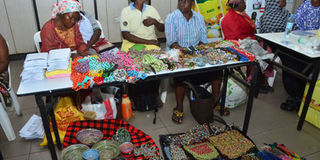Make money from producing Jewelry

Women showcasing jewelry during an exhibition at Uganda Manufacturers Association hall early this year. When starting this business, it is advisable to educate yourself on market availability with emphasis on cultural dictates so as not to clash with your would-be customers. PHOTO BY MICHAEL KAKUMIRIZI
What you need to know:
- Jewelry has for long been a preserve for women although some men are taking to it.
- As a business-minded person, you can go into making jewelries by investing in a jewelry store or shop.
You have been scratching your head on what to do in order to better your standard of living.
Making jewelries is one way to make money.
This business is about making ornaments such as rings, brooches, chains, and bracelets by cutting, shaping and polishing the material into a finished product.
Jewelry has for long been a preserve for women although some men are taking to it.
As a business-minded person, you can go into making jewelries by investing in a jewelry store or shop.
A jewelry store is a business establishment, usually retail in nature, which specialises in selling and buying jewelry.
Jewelry stores provide many services such as repairs, remodeling, restoring, designing and manufacturing pieces.
Capital
Ms Victoria Byoma, is a specialist in making jewelries, shares that with this kind of business the starting capital is affordable and one can start from their living room, garage or backyard.
She says that with as little as Shs20,000 one can start a jewelry business and the materials are readily available in shops in and around Kampala.
“With Shs20,000 you can buy the beads, strings and pair of scissors and start making the jewelry,” Ms Byoma adds.
However, according to Uganda Investment Authority (UIA) report on startups, for those who want to do it big, this business idea can aim at the production of 200 pieces of jewelry per day, translating into 62,400 pieces annually.
To be able to achieve this, the UIA report shows that one has to have a starting investment capital of about $1,580 (Shs5.7m) in the first year of operation. During this period the revenue potential is estimated at $62,400 (Shs226 million) annually with a net profit margin estimated at 39 per cent.
Production
The production of jewelry involves collecting, designing and decorating beads, horns, metals, stones, shells and joining them with threads and strings. Production is assumed for 312 days per year.
All the materials and equipment can be sourced locally and are readily available since this does not require sophisticated technology.
Market
Besides the huge local demand for jewelries, there is also the export demand within the region and outside Africa which can easily be tapped into with some extra investment.
Experts say that the market for jewels is constant throughout the year and could include the following: Beauty shops, market places, street vending places, work places, homesteads, saloons and tourist places.
Ms Byoma shares that selling directly to the public at a craft fair can help you interact with the customers directly.
“Many crafters and jewelry designers make significant profits at craft fairs because these shows are an affordable way to reach out to large amounts of pre-qualified individuals who are attending the fair specifically to look at and buy homemade crafts,” she adds.
Many craft fairs are annual events that give artists the opportunity to establish relationship with repeat customers and steadily build up a clientele who seeks out their work.




